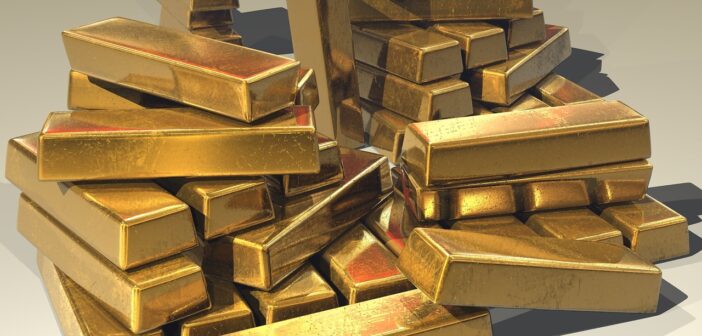credit:https://pixabay.com/
Gold prices have witnessed a significant rally recently, fueled by easing inflation concerns and renewed optimism about potential rate cuts. As the global economy grapples with shifting monetary policies and inflationary pressures, gold’s performance offers valuable insights into its role in modern portfolios and the broader market. This article explores the key factors behind this rally and delves into its implications for investors, central banks, and industries worldwide.
The Role of Gold as a Hedge Against Inflation in Modern Portfolios
Gold has maintained its status as a trusted store of value for centuries, particularly during periods of inflation when the purchasing power of traditional currencies tends to erode. In times of rising prices, gold often acts as a safe haven, as its value doesn’t directly hinge on the fluctuating fortunes of paper money or economic policies. However, with inflation now easing, many investors are redistributing capital into riskier assets like stocks and bonds, seeking higher returns in a more stable economic environment. Despite this, gold continues to attract attention due to its ability to hold its ground amidst uncertain global conditions, such as potential recessions or geopolitical tensions. Its low correlation with other assets—meaning it doesn’t typically move in tandem with equities or bonds—adds another layer of diversification to investment portfolios, allowing it to act as a risk mitigator while safeguarding wealth. Gold’s allure remains unshaken, providing not just a hedge against inflation but a reliable anchor in turbulent times, helping investors balance both growth and security in their long-term financial strategies.
Central Bank Policies and Their Influence on Gold Prices
Central banks wield significant influence over gold prices through their monetary policies, particularly in times of inflationary pressure. When inflation rises, the expectation of rate cuts typically gains traction, which is a favorable condition for gold. Lower interest rates diminish the opportunity cost of holding non-yielding assets like gold, making it more attractive to investors who seek safe havens in uncertain economic climates. Additionally, central banks themselves are among the largest buyers of gold, using it as a strategic hedge against economic volatility and to diversify their foreign exchange reserves. Nations like China and India, for instance, have been steadily accumulating gold, reducing their dependence on the US dollar. This dual impact—both the monetary easing from rate cuts and central banks’ accumulation of gold—creates a complex feedback loop that drives demand and upward pressure on gold prices. The intricate relationship between central bank policies, inflation expectations, and gold market trends illustrates how global economic strategies shape the precious metal’s value.
Impact of US Inflation Trends on Emerging Markets’ Gold Consumption
US inflation trends significantly shape global gold consumption, especially in emerging markets like India and China, where gold is not just an investment but also holds deep cultural significance. When US inflation softens, the US dollar tends to weaken, making gold more affordable for these countries. As a result, gold becomes an attractive asset to hedge against domestic economic uncertainty and currency volatility. This price sensitivity is amplified in regions where gold plays a pivotal role in cultural practices—such as weddings and festivals in India—boosting demand during certain times of the year. Additionally, easing inflation can lead to lower interest rates in the US, reducing the opportunity cost of holding non-yielding assets like gold. Thus, a combination of economic factors and cultural influences drives surges in gold purchases when US inflation eases, especially in these emerging economies.
Safe-Haven Assets vs. Risky Investments: Shifting Trends Amid Inflation Concerns
Gold’s reputation as a safe-haven asset shines particularly in times of economic instability, as it provides a hedge against a variety of risks that can erode the value of other investments. Unlike government bonds or the US dollar, which can be influenced by policy changes, interest rate fluctuations, or inflationary pressures, gold remains a tangible store of value, impervious to the whims of central bank actions. In an era of rising geopolitical tensions, financial sector vulnerabilities, and ongoing supply chain disruptions, gold’s physical nature and historical role as a wealth-preserving asset offer a unique safeguard against currency devaluation, safeguarding purchasing power and acting as a long-term stabilizer for portfolios. Its ability to transcend national borders and maintain intrinsic value in the face of economic turmoil is a key factor that sets gold apart from other traditional safe-haven assets.
Global Gold Supply Chain: Mining, Demand, and Pricing Dynamics
Gold’s market dynamics are intricately tied to both supply and demand forces that interact within a complex web of factors. On the supply side, mining output is critical, with geopolitical stability in major mining regions like Africa and South America directly affecting gold production. Political unrest, labor strikes, or even regulatory changes in these areas can disrupt supply, driving prices higher. Technological advancements in extraction methods can alleviate some of these challenges by improving efficiency and unlocking previously inaccessible gold deposits. However, environmental concerns and regulations often create friction, limiting the scale and speed of mining activities. On the demand side, the allure of gold as a hedge against inflation and a safe haven during economic instability boosts central bank purchases, while consumer preferences in jewelry, especially in countries like India and China, fuel ongoing demand. Furthermore, industrial uses of gold in electronics and other sectors keep its demand robust. The recent price surge highlights the fragile equilibrium between these forces, where any shift—be it in mining costs, technological progress, or economic sentiment—can have ripple effects on global prices.
Technological and Industrial Uses of Gold in an Inflationary Context
Gold’s role extends far beyond its traditional investment and ornamental uses, emerging as a cornerstone in high-tech industries. Its exceptional conductivity allows for efficient electrical connections, while its resistance to corrosion ensures longevity in electronics, where even the tiniest, most durable components are essential. Its malleability makes it ideal for intricate designs in aerospace, where lightweight and reliable materials are a must. In the medical field, gold’s biocompatibility and non-reactive nature are crucial in implants, diagnostic devices, and treatments. As inflation stabilizes and production costs lower, the surge in demand for innovative technologies, especially in green energy and cutting-edge electronics, will likely elevate gold’s value even further, solidifying its indispensable position in the modern global economy. This shift towards a technology-driven demand reflects the growing importance of materials that can withstand the pressures of innovation while maintaining sustainability and efficiency.
Conclusion
The rally in gold prices amid easing inflation concerns highlights the asset’s enduring significance in the global financial landscape. From its role as a hedge against inflation to its industrial applications and supply chain intricacies, gold continues to be a critical indicator of economic sentiment.
As central banks recalibrate policies and investors navigate an evolving market landscape, gold remains a vital component of diversified portfolios. Its resilience and versatility ensure its place as both a safe-haven asset and a driver of industrial innovation.
References:
- World Gold Council. (2023). Gold Demand Trends Report. Retrieved from www.gold.org
- Federal Reserve Economic Data. (2023). US Inflation and Interest Rates. Retrieved from www.federalreserve.gov
- International Monetary Fund. (2023). Gold Reserves by Central Banks. Retrieved from www.imf.org
- Bloomberg. (2023). Gold Market Analysis. Retrieved from www.bloomberg.com



